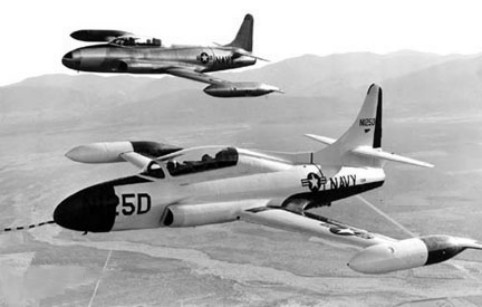- T2V SeaStar
infobox Aircraft
name = T2V-1 / T-1 SeaStar
caption = A T2V-1 (T-1A) SeaStar (foreground) and a TV-2 (T-33B) Shooting Star in flight in the early 1950s
type = Naval training aircraft
manufacturer =Lockheed
designer =
first flight =15 December 1953
introduced = May 1957
retired = 1970s
status =
primary user =United States Navy
more users =
produced =
number built = 150
unit cost =
developed from =T-33 Shooting Star
variants with their own articles =The
Lockheed T2V SeaStar, later called the T-1 SeaStar, was a turbojet trainer aircraft for the U.S. Navy that entered service in May 1957. It was developed from the Lockheed T-33 and powered by oneAllison J33 engine.Design and development
It was based upon the Lockheed L-245 design of an updated T-33/P-80 reworked into a naval version for carrier operations. The Navy used the T-33 as the TV-2 (intially TO-2) starting in 1949 for land based jet aircraft training, but this model was not usable on aircraft carriers. Based on the more advanced design development of the P-80 family, the T2V had to be almost totally re-engineered for carrier landing and at-sea operations with a redesigned tail, naval standard avionics, a strengthened undercarriage (with catapult fittings) and lower fuselage (with a retractable arrestor hook), and power-operated leading-edge flaps (to increase lift at low speeds) to allow carrier launches and recoveries, and an elevated rear (instructor's) seat for improved instructor vision, among other changes.
Unlike other P-80 derivatives, the T2V could withstand the shock of landing on a pitching carrier deck and had a much higher ability to withstand sea water related aircraft wear from higher humidity and salt exposure. The Navy did also fly a number of T-33s for land-based training operations, designated TV-2, which should not be confused with the T2V (T-1 SeaStar).
Operational history
The aircraft was initially designated T2V-1 when it enter service, but was re-designated T-1A SeaStar under the
1962 United States Tri-Service aircraft designation system under which it name it would spend the majority of its career.It was replaced by the
T-2 Buckeye but remained in service into the1970s .Operators
;USA
*United States Navy pecifications (T2V-1)
aircraft specifications
plane or copter?= plane
jet or prop?= jet
ref=
crew= Two (student & instructor)
capacity=
length main= 38 ft 6.5 in
length alt= 11.75 m
span main= 42 ft 10 in
span alt= 13.05 m
height main= 13 ft 4 in
height alt= 4.06 m
area main= 240 ft²
area alt= 22.3 m²
airfoil=
empty weight main= 11,965 lb
empty weight alt= 5,438 kg
loaded weight main= 15,500 lb
loaded weight alt= 7,045.45 kg
useful load main=
useful load alt=
max takeoff weight main= 16,800 lb
max takeoff weight alt= 7,636 kg
more general=engine (jet)=
Allison J33 -A-24/24A
type of jet=turbojet
number of jets=1
thrust main= 6,100 lbf
thrust alt= 2,772 kN
thrust original=
afterburning thrust main=
afterburning thrust alt=max speed main= 521 knots
max speed alt= 600 mph, 973 km/h
cruise speed main=
cruise speed alt=
never exceed speed main=
never exceed speed alt=
stall speed main=
stall speed alt=
range main= 782 nm
range alt= 900 mi, 1,448 km
ceiling main= 40,000 ft
ceiling alt= 12, 200 m
climb rate main= 6,300 ft/min
climb rate alt= 32 m/s
loading main=
loading alt=
thrust/weight=
power/mass main=
power/mass alt=
more performance=armament=
avionics=ee also
aircontent
related=
*T-33 Shooting Star
*P-80 Shooting Star similar aircraft=
* F9F-8T/TF-9J Cougar
* TA-4F/J Skyhawk
*Fouga Zéphyr
*T-2 Buckeye
*T-45 Goshawk lists=
see also=
References
* Ginter, Steve. "Lockheed T2V-1/T-1A Seastar. Naval Fighters #42". Simi Valley, California: Ginter Books, 1999. ISBN 978-0-942612-424.
* Green, William, with Gerald Pollinger." The Aircraft of the World". New York; Doubleday & Co., 1965. P. 255.
* Green, William, with Dennis Punett. "MacDonald World Air Power Guide". London; Purnell & Sons, Ltd. (reprinted by Doubleday), 1963. P. 28.External links
* [http://www.history.navy.mil/branches/avchr8.htm "Naval Aviation Chronology 1954-1959" chapter from "United States Naval Aviation 1910-1995" book.]
Wikimedia Foundation. 2010.
